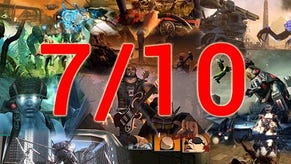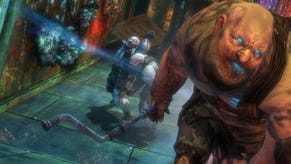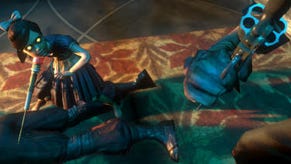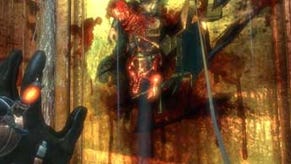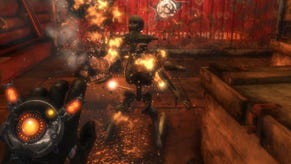Wot I Think: Singularity
Raven's Singularity is now available. I've manipulated my time such that I've played it from beginning to end, in that order, and can now tell you Wot I Think.
If I had a magical time glove, do you know what I’d do? Eh? Eh? I’d go back to the beginning of the Singularity’s development and tell the developers all the mistakes they were going to make!
No, this is a lie. Not only because I’d think of far better things to do with such a tool, but because that’s not how it works. It’s a tool that can only manipulate objects that are infused with E99, a compound discovered by Russian scientists in the 1950s, that leads to the timeline getting all confused, such that the Russians are tyrannically ruling the modern world. Well, that won’t do, so it’s up to you to put on the glove and put right what once went wrong.
The result is a corridor shooter. Which, by genre, is a good thing. Can we please end this nonsense about there being something wrong with being a corridor shooter – they’re great. It’s like complaining that a new RTS is just yet another game showing the armies from above. The question is, is it a good corridor shooter. And the answer is: it’s complicated.
The story is loud and wobbly, but in the end completely irrelevant to your experience of playing. You travel back and forth between the present day degrading Russian island, and the 1950s period during which the E99 incidents began. But you don’t choose to – that’s all scripted for you. What you can choose to do is move E99-enthused objects through time. A barrel from the 1950s might be old and crumpled now, so zap it and it’ll be like new. New enough to pick it up and throw it explosively at the enemies.
The other major impact time has upon you is the nature of those enemies. Soldiers of the 50s are horribly mutated by the chemical into mutant creatures, meaning there’s a lot of variety in enemy.
Time echoes all over the place, meaning you’ll see strange ghostly manifestations of the past in the present, which sometimes results in creatures reappearing in the present day, other times just filling in the plot as you plough through. And plough through you will.
Variety really does seem to be the central theme. You’ve got a big pile of guns, two of which can be carried at any time. These can then be augmented with various weaponry updates, improving their damage, clip size and accuracy. Then your time glove, not only able to move inert objects through time, can take organic E99-infectees into their decomposed futures. Or you can fire a burst of energy at them that might evaporate them inside their skins. Or the glove works as a gravity gun, letting you throw chairs and boxes at them. How you go about fighting depends on the rations of ammo and energy. The glove keeps on giving – later it can create a time-slowing orb in which you can trap enemies, and later still will let you turn humans into mutants, so they turn on their fellow men.
Augmentation doesn’t stop at weapons. You can improve yourself through lots of different bonuses, letting you improve your speed, defences, attacks, and various tweaks to your skills and capacity. And the glove itself is constantly updated with new abilities.
Singularity throws a lot at you, very quickly.
For the first couple of hours, this seems a lot of fun. It’s a traditional shooter, but the time manipulation implies a lot of fun to be had. It’s very satisfying to see a collapsed staircase and restore it with a zap. It’s fun watching the pieces slot back together. But, well, that’s about it. Early on you’ll find and old collapsed crate, and a descending door too low to crawl under. So you put the crate in the gap, then restore it. That pushes the door up, and you’re through! So what other time-manipulating puzzles can we expect? Er, none. That’s the only one they seemed to think of, repeated throughout the game. There’s some stuff moving stairs out the way, but nothing else that imaginatively uses the glove for completing tasks.
However, the larger issue isn’t the lack of imagination. It’s the lack of balance. The middle portion of the game is by far the hardest bit, the final third a complete synch. For mad reasons, the middle section gives you nowhere near enough ammo, scatters its checkpoints unbelievably stupidly, and throws volumes of mutant enemies at you in ludicrous packs. Oh, and it features the ticks.
The ticks are scuttling bugs with explosive backs, that charge toward you in suicidal swarms, detonating themselves when they reach you. Clearly all small bug creatures in all games always suck harder than a black hole drinking a McDonald’s milkshake, and these underline the rule. Just a couple of them exploding can be enough to kill you, and they often charge at you from behind. Brilliant! Fighting off a large number of them is tedious, a massive waste of energy or bullets, and as much fun as the fly that keeps buzzing in my face as I write this. Both have been very loudly told to go away with some rather rude words.
This is also the section that contains both the boss fights. Neither is particularly difficult, but both is completely incongruous to the whole game. Suddenly you’re shooting at the orange glowing sections of a big wobbly creature, as if playing a 1990s Nintendo game. Damn time glove, always messing up.
The checkpointing seems to have been designed by someone wanting to lecture on why bad checkpointing can be so ruinous, and needing an exaggerated example of how to do it badly. Immediately before a cutscene? Absolutely. Before the room with all the machines for purchasing upgrades? Of course! None for a long stretch of extremely treacherous scenes, each involving some sort of set-piece? You betcha. Again, by the final third this improves, although things get so simple you rarely need them.
Then the niggles pile in. You know how most games let you jump into a crawl space? Singularity lets you skip this by the simple process of having to find a crate somewhere, manipulate it to the modern day, then put it in front of the hole, to get in. Thanks! You can sprint for about three seconds. The audio settings are so daft you can’t push voices higher than background noise, and as such most of the endless nattering is lost to the ambience. And for a game that’s about manipulating time, you can’t flipping skip the cutscenes.
As I mentioned, the final third is peculiarly easy. Suddenly you’re spammed with ammo, upgrades, etc, surely building you up for a dramatic finish? Except, no. The game, while visually larger and more dramatic, fizzles in challenge. There’s no final dramatic boss. There’s no epic battle for which all this sudden help is needed. In fact, there’s a very, very weak attempt at a multiple choice ending that falls out of the sky with no anticipation.
It’s obvious that that Raven have tried to evoke other games in their development. The colour palette and attempt to tell story is very BioShock, while the combat and nod toward using cover (there’s no actual option to take cover) says thank you to Halo. And that storytelling does require a short piece of mocking.
The tale, for what it is, is voluminous, but strangely hard to engage with. The Russians, they sure created the E99 devices, bombs, experiments… And we’re sure going to get told about them, an awful lot. This is sometimes in the form of time echoes, but mostly in that ever-endearing and completely daft system of individuals scattering a city with chronological diary entries, and reel-to-reel recordings of their thoughts. But here there isn’t a larger point being made, no narrative trick. It’s purely the story madly scattered throughout, and it’s so stark as to make me giggle.
An attempt to create an Alyx-alike also falls rather embarrassingly short. She accompanies you here and there, and is as nicely animated, but has no discernible personality on the occasions you can hear her above the background noise.
Singularity does no favours for my argument about there being nothing wrong with a corridor shooter. It seems to systematically try to make every mistake with which the genre is synonymous. None of this makes it a bad game by any stretch, and any time you’re fighting the soldiers there’s a lot of fun to be had. Fighting the mutants is much more of a slog, and the inclusion of the ticks was wanton stupidity. But overall it feels like a muddle. Even the graphics feel muddled, varying from beautiful scenes to environments with textures that look like they’re from the 80s.
It begins well, it ends too easily, and it drags frustratingly in the middle. But the biggest crime is the lack of imaginative ways to manipulate time. On most occasions anything impressive you do is foisted upon you. And there’s such a troubling lack of variation in the tricks for progression that at one point I wondered if I was playing an earlier level a second time. Perhaps a time-manipulation joke. Sadly the wit behind the game doesn’t extend to that either – it was simple repetitive.
I think what you get out of Singularity may, like BioShock as it happens, depend a lot upon how you approach it. Battles can mostly be easily finished with the regular weapons. But be imaginative, using objects in the environment (explosive barrels of course, but also canisters of liquid nitrogen for shattering fun), and play with the glove’s abilities, and you can create more interesting situations. You don’t need to, but you’ll likely have more fun along the way if you do.
Take the core ideas here, strip out vast amounts of the fuss and noise, and focus on a more puzzle-centric approach, and Singularity could have been a quirky classic. As it is, it’s yet another corridor shooter to add to the pile of decent enough corridor shooters.








